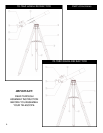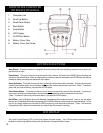
M
ALIGNING FINDERSCOPE
Look through Main Telescope Tube and establish a well-defined target. (see focusing telescope section)
Looking through Wide Field Finderscope, alternate tightening each Finderscope Adjustment Screw until crosshairs of Wi d e
Field Finderscope are precisely centered on the same object already centered in Main Telescope Tu b e ’ s field of view.
N o w, objects located first with the Wide Field Finderscope will be centered in the field of view of the main telescope.
M
SELECTING AN EYEPIECE
M
FOCUSING TELESCOPE
1. After selecting the desired eyepiece, aim main telescope tube at a land-based target at least 200 yards away
(e.g. Atelephone pole or building).
2. Fully extend focusing tube by turning Rack and Pinion Focusing Mechanism.
3. While looking through selected eyepiece (in this case the 20 mm), slowly retract focusing tube by turning Rack
and Pinion Focusing Mechanism until object comes into focus.
You should always start viewing with the lowest power eyepiece, which in this case is the 20 mm lens. Note: the base
power of each eyepiece is determined by the focal length of the telescope objective lens. A formula can be used to
determine the power of each eyepiece: telescope OBJECTIVE lens focal length divided by EYEPIECE focal length =
M A G N I F I C ATION (e.g. Using the 20 mm lens, a sample calculation could look like this: 750 mm / 20 = 38x or 38
p o w e r. Telescope models will vary in focal length.)
Included with this telescope is a Barlow lens. Barlow lenses are used to double or triple the power of your telescope.
Place your Barlow between the focusing tube and the eyepiece. Using the example above, your 3x Barlow lens would
give you a total power of 114x or 114 power. (38 x 3 = 114x or 114 power). The magnification calculation would look like
this: 750 mm /20mm = 38 power. 38 power x 3=114 power.
Detailed Assembly (continued)
Never Look Directly At The Sun With Your
Telescope Permanent Damage
To Your Eyes May Occur
❂
9.


















